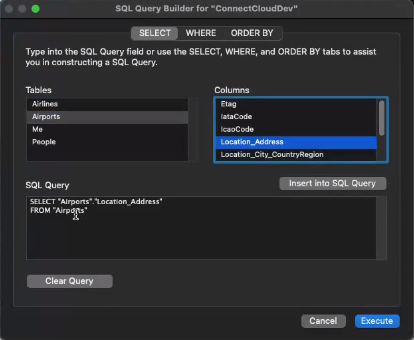Discover how a bimodal integration strategy can address the major data management challenges facing your organization today.
Get the Report →Connect to Azure Data Lake Storage Data from Filemaker Pro (Mac)
Use CData Connect Cloud to connect to and query live Azure Data Lake Storage data from Filemaker Pro on Mac.
FileMaker Pro is a cross-platform relational database application that allows users to visually modify a database. When paired with CData Connect Cloud, FileMaker Pro gets access to live Azure Data Lake Storage data. This article demonstrates how to connect to Azure Data Lake Storage using Connect Cloud and query Azure Data Lake Storage data in FileMaker Pro.
CData Connect Cloud provides a pure SQL Server interface for Azure Data Lake Storage, allowing you to query data from Azure Data Lake Storage without replicating the data to a natively supported database. Using optimized data processing out of the box, CData Connect Cloud pushes all supported SQL operations (filters, JOINs, etc.) directly to Azure Data Lake Storage, leveraging server-side processing to return the requested Azure Data Lake Storage data quickly.
Configure Azure Data Lake Storage Connectivity for FileMaker Pro
Connectivity to Azure Data Lake Storage from FileMaker Pro is made possible through CData Connect Cloud. To work with Azure Data Lake Storage data from FileMaker Pro, we start by creating and configuring a Azure Data Lake Storage connection.
- Log into Connect Cloud, click Connections and click Add Connection
- Select "Azure Data Lake Storage" from the Add Connection panel
-
Enter the necessary authentication properties to connect to Azure Data Lake Storage.
Authenticating to a Gen 1 DataLakeStore Account
Gen 1 uses OAuth 2.0 in Azure AD for authentication.
For this, an Active Directory web application is required. You can create one as follows:
To authenticate against a Gen 1 DataLakeStore account, the following properties are required:
- Schema: Set this to ADLSGen1.
- Account: Set this to the name of the account.
- OAuthClientId: Set this to the application Id of the app you created.
- OAuthClientSecret: Set this to the key generated for the app you created.
- TenantId: Set this to the tenant Id. See the property for more information on how to acquire this.
- Directory: Set this to the path which will be used to store the replicated file. If not specified, the root directory will be used.
Authenticating to a Gen 2 DataLakeStore Account
To authenticate against a Gen 2 DataLakeStore account, the following properties are required:
- Schema: Set this to ADLSGen2.
- Account: Set this to the name of the account.
- FileSystem: Set this to the file system which will be used for this account.
- AccessKey: Set this to the access key which will be used to authenticate the calls to the API. See the property for more information on how to acquire this.
- Directory: Set this to the path which will be used to store the replicated file. If not specified, the root directory will be used.
![Configuring a connection (Salesforce is shown)]()
- Click Create & Test
-
Navigate to the Permissions tab in the Add Azure Data Lake Storage Connection page and update the User-based permissions.
![Updating permissions]()


Add a Personal Access Token
If you are connecting from a service, application, platform, or framework that does not support OAuth authentication, you can create a Personal Access Token (PAT) to use for authentication. Best practices would dictate that you create a separate PAT for each service, to maintain granularity of access.
- Click on your username at the top right of the Connect Cloud app and click User Profile.
- On the User Profile page, scroll down to the Personal Access Tokens section and click Create PAT.
- Give your PAT a name and click Create.
- The personal access token is only visible at creation, so be sure to copy it and store it securely for future use.

Connect to Azure Data Lake Storage from FileMaker Pro using Connect Cloud
To establish a connection from FileMaker Pro to the CData Connect Cloud Virtual SQL Server API, follow these steps.
Configure the ODBC Connection to CData Connect Cloud
- Download and install the Actual ODBC Driver for SQL Server (actualtech.com)
- Configure a DSN for the Actual ODBC driver by setting the following properties:
- URL: tds.cdata.com
- Port: Change the port from 1433 to 14333
- Username: Your Connect Cloud email address
- Password: the PAT you created earlier
Query Azure Data Lake Storage from FileMaker Pro
- In the SQL Query Builder "SELECT" tab, select the columns to include as part of the query.
![Configuring the query by selecting columns.]()
- Open the "WHERE" tab of the SQL Query Builder and select "Show only selected columns."
- In "Table.Column,"" select a table and a column name.
- Set the "Operator" to =.
- Select "Column," and then select the same table and column name as "Table.Column."
- Click "Insert into SQL Query."
![Configuring the query by setting the WHERE clause.]()
- If no other modifications to the SQL query are required, click "Execute."
Get CData Connect Cloud
To get live data access to 100+ SaaS, Big Data, and NoSQL sources directly from your SQL Server database, try CData Connect Cloud today!









